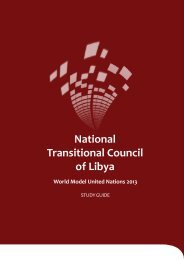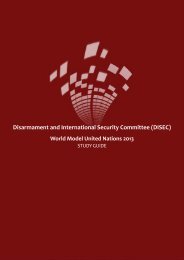Paris Peace Summit, 1971 - World Model United Nations
Paris Peace Summit, 1971 - World Model United Nations
Paris Peace Summit, 1971 - World Model United Nations
You also want an ePaper? Increase the reach of your titles
YUMPU automatically turns print PDFs into web optimized ePapers that Google loves.
I N T R O D U C T I ON<br />
It is a conict known to Americans and Westerners as<br />
the “Vietnam War.” But the ghting that occurred in<br />
Vietnam between 1961 and 1975 goes by dierent names to<br />
the varied belligerents. To the Vietnamese, who have seen<br />
foreign intervention time and again it is the “American War;”<br />
Vietnamese communists call it the “Resistance War Against<br />
America.” To scholars seeking detached terminology, it is<br />
the “Second Indochina War”—marking the continuation<br />
of a previous, unnished battle that aected not only<br />
Vietnam, but neighboring Cambodia and Laos—or the<br />
“Vietnam Conict”—acknowledging that the <strong>United</strong> States<br />
Congress never actually declared war on the Southeast Asian<br />
nation. Such varied terminology is perhaps evidence of the<br />
contrasting points of view and the controversy surrounding<br />
the Cold War-era conict.<br />
e <strong>Paris</strong> <strong>Peace</strong> <strong>Summit</strong> meets in <strong>1971</strong> amid weariness and<br />
popular discontent on all sides for the repercussions of the<br />
lengthy war. e central question of this committee is, if the<br />
belligerents of the Vietnam War had made dierent choices<br />
at the negotiating table, could a long-term peace in South<br />
Vietnam be achieved? To answer this question, this committee<br />
will gather the parties involved in the Vietnam War to debate<br />
the conditions for peace—and if peace is possible, to cra<br />
the principles that will ensure lasting national and regional<br />
prosperity.<br />
is committee’s focus is not only on the short-term technical<br />
or military aspects of an end to conict—discussion of<br />
regional issues and, indeed, the international backdrop of a<br />
bipolar world will be critical to coming to an agreement. e<br />
e American delegation participated in a series of talks to<br />
formulate a treaty to end the war in Vietnam.<br />
purpose of this study guide is to help delegates gain a full<br />
understanding of the factors behind the conict in Vietnam,<br />
as well as the motivations and interests of each party to the<br />
war. However, please keep in mind the need for additional<br />
research, and please feel free to contact me if you have any<br />
questions.<br />
Over half of the guide comprises the History and Discussion<br />
of the Issue, which explains the development of a fractured<br />
Vietnam, from the rst foreign domination under the<br />
Chinese onwards. e rest of the guide provides additional<br />
helpful information and advice, including the substantively<br />
oriented Proposed Solutions, and Suggestions for Further<br />
Research.<br />
In the spirit of the crisis committee, all actions of the <strong>Paris</strong><br />
<strong>Peace</strong> <strong>Summit</strong> will be up to you and your fellow delegates<br />
to decide. In a year when tensions are higher than ever<br />
before, disagreement could bring yet more escalation—and<br />
cooperation could usher in a new era of national peace. Best<br />
of luck, and I hope that this study guide will be useful in your<br />
preparations.<br />
HISTORY & STRUCTURE OF THE COMMITTEE<br />
The <strong>Paris</strong> <strong>Peace</strong> <strong>Summit</strong> comes together on January 1,<br />
<strong>1971</strong>, with the common hope that the new year will push<br />
forward the end to the conict in Vietnam. Present in <strong>Paris</strong><br />
are delegates from the <strong>United</strong> States of America, the Republic<br />
of Vietnam (South Vietnam), the Union of Soviet Socialist<br />
Republics, the Democratic Republic of Vietnam (North<br />
Vietnam), and the National Liberation Front (Viet Cong).<br />
While the Soviet Union did not attend the <strong>Paris</strong> <strong>Peace</strong> Talks in<br />
the real timeline of history, their presence at this simulation<br />
of the <strong>Paris</strong> <strong>Peace</strong> <strong>Summit</strong> reects the instrumental part they<br />
played in materially and ideologically supporting the North<br />
Vietnamese cause. A team of three individual delegates will<br />
represent each nation. Each team, comprising delegates from<br />
dierent universities, will work in tandem to push forward<br />
their respective nation or group’s objectives. Delegates<br />
representing nations will include the ministries of defense<br />
and foreign aairs, and advisors or negotiators.<br />
Following a lengthy period of debate and political<br />
maneuvering to bring every side to the negotiating table, the<br />
rst meeting in <strong>Paris</strong> took place on May 10, 1968.<br />
Powers of the Committee<br />
The committee’s mission is to dra an accord that will<br />
end the war and restore peace in Vietnam. erefore,<br />
Harvard <strong>World</strong>MUN 2012 PARIS PEACE SUMMIT <strong>1971</strong> 4
















